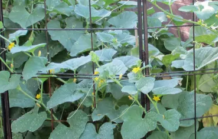We sometimes receive calls from gardeners who wish to donate houseplants that have outgrown their location. In most cases, we don’t have room to accept plants and suggest that people bring them down to size by air-layering. Air-layering is a process where a branch or the main stem is encouraged to form roots while still attached to the parent plant. After rooting, the original plant is discarded and the newly rooted one is potted as a replacement. Though this propagation technique cannot be used on all houseplants, it does work well on many that tend to outgrow their boundaries including croton, dracaena, dieffenbachia, Norfolk Island pine, rubber plant and schefflera.
It is best to choose wood that is about 1 year old. Older or more immature wood often roots poorly, if at all. Any place on the stem that is of the proper maturity can be used, but a convenient location is often about 12 inches from the tip. Following are the steps required for air-layering:
* Leaves should be removed around the area to be air-layered.
* Wound the stem. This can be done by making a slanting cut upward, an inch or more in length and halfway through the stem. Place a portion of a toothpick in the cut so it cannot close and heal. If the stem is seriously weakened, use a stick “splint” to prevent breakage.
Another method that works well is to strip the bark completely around the stem in a band one-half to one inch wide.
* Apply rooting hormone to the wounded surface of the cut or the stripped portion of the branch.
* Pack a baseball-sized wad of moist, unmilled sphagnum peat moss around the wounded area so it forms a ball. This is where new roots will form. It is important to use the long, stringy unmilled peat moss rather than the more common milled material so peat moss does not fall away from the stem when released. Even unmilled peat moss may need to be secured with string to keep it in place.
* Wrap the ball of sphagnum peat moss with clear plastic wrap. Be sure to use enough wrap so that the plastic overlaps and prevents the ball from drying out. Secure the top and bottom edges of the wrap closed with electrical tape, string or other convenient fasteners.
Roots may appear in as little as a month though it may take much longer for the plant to be ready for transplanting. Check periodically to be sure peat moss remains moist. Water if needed. When roots have filled the peat moss, the plant is ready to be severed from the parent and transplanted. (Ward Upham)




